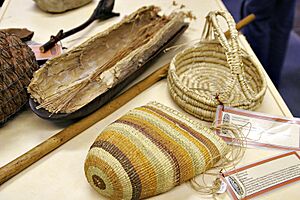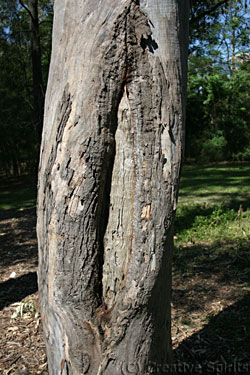Coolamon (vessel) facts for kids

A coolamon is a special carrying dish used by Aboriginal Australians. It's like a shallow bowl or canoe shape, usually made from wood. These handy tools were used for many things, from carrying water and food to cradling babies.
Contents
What is a Coolamon?
Coolamons are shallow, curved vessels that look a bit like a canoe. They can be from 30 to 70 centimeters long. For a very long time, Aboriginal women traditionally used coolamons for many daily tasks. They would carry water, collect fruits and nuts, and even gently hold newborn babies in them.
Today, when women gather bush tucker (food from the wild), they often use modern items like buckets. But in the past, coolamons were essential.
How Coolamons Were Used
When traveling long distances, coolamons were often carried on the head. To make this more comfortable, a soft ring pad was placed on the head first. This pad was called akartne in the Arrernte language. It could be made from possum fur, human hair string, twisted grass, or feathers. This helped to cushion and support the coolamon, just like how people in other cultures around the world carry things on their heads.
The Pintupi people from the Western Desert area would sometimes attach a plaited rope to their coolamons. This rope, called ngalyibi, was made of hair or plant fiber. It allowed them to sling the coolamon over their shoulders. Smaller coolamons were even worn as hats, with the twine tied under the chin!
Coolamons were also used for other important jobs. They helped with winnowing grains, which is a way of separating the good parts of a plant from the husks. This was part of making bush bread. They could also be used for heating and cooking food. Sometimes, they even served as a quick umbrella to keep off the rain!
Making a Coolamon

Coolamons were generally made by men. They were usually crafted from strong hardwood trees, like the mallee tree. In Central Australia, the bean tree was often used.
To make a coolamon, a piece of the outer bark was carefully removed from the tree. This bark was then shaped over a fire to give it its special curved sides. Deep ridges were made using a sharp quartz stone knife. After shaping, the coolamon needed to sit for several days. A stick of wood was often placed inside to hold it open and stop it from losing its shape. Sometimes, coolamons were also made from a natural knot or lump on a tree, called a “wirree.”
Decorating Coolamons
Coolamons were often beautifully decorated on the outside. They had different etchings and designs. These designs could show tribal symbols or special animal spirits, known as totems. Coolamons were also used in ceremonies, such as for special smoking rituals. These rituals were believed to have purifying effects. To keep the wood in good condition, coolamons were regularly rubbed with fat, like emu fat.
Different Names for Coolamons
The word "coolamon" is used in New South Wales. But in other parts of Aboriginal Australia, different names are used. For example, the Pitjantjatjara people call it piti. The Bardi people call it oorlarda. And the Noongar people use the name yandi.
See also

